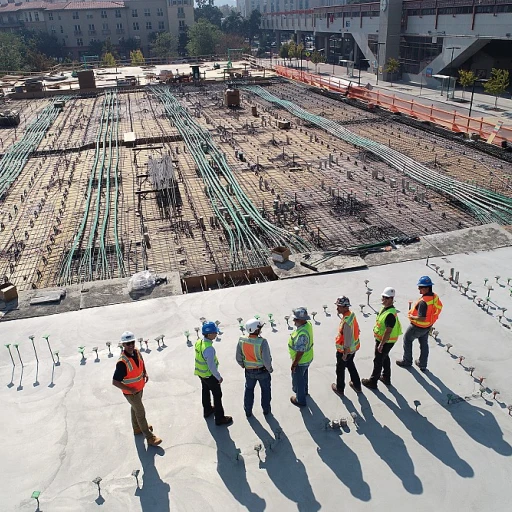Understanding Team Dynamics in Work Tech
The Foundation of Team Dynamics in Tech Workspaces
Understanding team dynamics in work tech is essential for fostering environments where collaboration and productivity thrive. The dynamics of a team are influenced by various factors, such as communication patterns, roles and responsibilities, and the individual attributes of team members. These factors play a significant role in determining how effectively a team operates.
The tech space, with its rapid evolution and need for constant innovation, demands dynamic teams that can adapt quickly to new challenges. To reach their goals efficiently, members of these teams must engage in open communication and provide constructive feedback. It is crucial for a team to establish trust among its members to create a positive team environment.
Clear communication helps in setting defined roles and responsibilities within the group, which is a key component of effective team dynamics. When team members have a clear understanding of their roles, they can contribute more effectively to the success of the project. As such, the dynamics within a team are not determined solely by the individual skills of each member but also by how these members interact with each other.
Incorporating strategies like team building activities and conflict resolution measures can significantly improve team dynamics. Organizations should aim to create environments where team members feel valued and empowered to express their ideas. This not only facilitates better decision making but also strengthens the bond among team members.
For more insights on enhancing workplace interaction, particularly through the implementation of communication platforms, you can explore further on enhancing workplace interaction.
Key Elements of Effective Team Dynamics
Essential Ingredients for Successful Group Dynamics
In the rapidly evolving landscape of work tech, understanding the pivotal elements that contribute to effective team dynamics is crucial. The cornerstone of any successful team is its ability to foster a positive and functional environment where members feel valued and understood. Let’s dive into the core elements integral to successful team dynamics in this context.
- Open Communication: Clear communication is the bedrock of effective teams. Ensuring that team members have the ability to express ideas, insights, and concerns freely is essential for collaboration. This extends to both verbal and non-verbal communication, where technology plays a significant role in enabling constant and seamless interaction. Enhancing workplace interaction through the right platforms can mitigate misunderstandings and improve team dynamics.
- Trust and Collaboration: Cultivating trust among team members is paramount. When trust is established, collaboration becomes more fluid and effective. Leaders and members alike must contribute to a culture where trust is the norm, encouraging open communication and mutual respect, which are vital for achieving both short-term and long-term goals.
- Clearly Defined Roles and Responsibilities: Every team member should have a clear understanding of their roles within the team. This clarity helps in reducing confusion and ensures that each member can focus on their specific tasks, leading to enhanced productivity and a more organized approach to achieving goals.
- Constructive Feedback and Conflict Resolution: Providing constructive feedback is crucial for growth and improvement. Feedback should be delivered in a way that is encouraging rather than discouraging, fostering an environment where team members can learn and improve. Moreover, effective conflict resolution strategies are vital to addressing and resolving disputes swiftly, preventing them from hindering team progress.
- Strong Leadership: A capable team leader can significantly influence team dynamics. Leaders should inspire, motivate, and support their team members, setting a positive example in handling pressure and steering the team toward success.
Individually, each of these elements contributes to the construct of a positive team dynamic. Combined, they create an environment conducive to productivity and harmony, even as challenges arise from constantly changing work tech landscapes. This requires ongoing attention and adaptation to maintain balance and effectively support team goals.
Real-World Examples of Effective Team Dynamics
Putting Team Dynamics into Practice: Real World Applications
To comprehend the intricate nature of team dynamics in a work tech environment, diving into real-life scenarios can provide a pragmatic understanding. Effective teams, characterized by a collaborative culture and clear communication, showcase success stories when every team member's roles and responsibilities are well-defined. Examining successful cases uncovers insights on how communication and trust set the backdrop for teams to flourish.
Consider a tech company embarking on a sizable project requiring an interdisciplinary approach. Each member, well-versed in their domain, plays a part in the success story. The team's leader orchestrates not only the technical work but also the group dynamics by fostering open communication. In such an environment, team members feel empowered to share constructive feedback, knowing it is welcomed and essential for conflict resolution and decision-making processes.
A pivotal aspect of such collaboration is the establishment of clear goals. Often, a team leader will use targeted team building activities to align objectives and underscore the importance of each person's contribution. By creating a space where members can voice concerns without reservations, the team cultivates trust, making room for more seamless and effective collaboration.
In another instance, a project might demand the integration of multiple technological tools to achieve cohesive teamwork. Companies have notably benefited from robust software solutions for multifamily reporting which streamline work and foster improvements in team dynamics. Such tools, by simplifying roles and enhancing communication, prove integral in upholding an environment where every team member can contribute to shared goals.
Additionally, companies that prioritize continuous growth often evolve their strategies to incorporate feedback loops. By seeking and implementing feedback, these organizations demonstrate the power of dynamic team structures that are responsive and adaptable to change. Here, the leader guides the direction while the team adapts, leveraging the strengths of each team member to overcome challenges.
In summary, real-world examples of effective team dynamics underline the necessity of a well-coordinated approach. Through clarity in communication, trust building, and alignment of goals, these teams harness the synergy required to thrive in today's fast-paced work tech landscape. Organizations looking to emulate this success must recognize how crucial these elements are in forging a positive team environment.
Challenges in Building Effective Team Dynamics
Overcoming Obstacles on the Path to Effective Collaboration
In the pursuit of optimizing team dynamics, organizations often face a myriad of challenges. Understanding these obstacles is crucial to ensuring that work technology can effectively address them.
One major hurdle is the lack of clear communication. When team members fail to articulate their ideas and responsibilities transparently, it can lead to misunderstandings and project delays. To counteract this, team leaders can encourage open communication and facilitate an environment where constructive feedback is the norm.
Conflict resolution is another significant challenge. Disparate opinions and conflicting priorities can arise, sometimes impeding progress. It's essential for team leaders to mediate such conflicts and guide the team toward achieving their shared goals.
Building trust within the team is also vital. Trust among team members fosters a positive team environment where individuals feel valued and heard. However, building and maintaining this trust requires consistent efforts in team building activities and clear communication.
Group dynamics play a crucial role in determining a team's success. Misunderstanding roles and responsibilities can lead to confusion and inefficiencies. Effective team leaders clarify these roles, ensuring everyone knows their part and how they contribute to the larger goals.
Moreover, team members' differences can sometimes hinder progress. Whether it's differences in work styles, cultural backgrounds, or skill levels, teams must learn to leverage these differences to improve team performance. By embracing diversity, teams can gain new perspectives, which can enrich decision-making processes.
In the landscape of work tech, knowing these challenges allows teams to strategically implement strategies to overcome them. As organizations strive for more effective collaboration and team dynamics, addressing such issues can lead to significant improvements.
The Role of Technology in Enhancing Team Dynamics
Harnessing Technology for Improved Team Dynamics
In today's fast-paced work environment, leveraging technology is crucial for enhancing team dynamics. With rapid advancements and the integration of various digital tools, teams can cultivate a more collaborative and effective atmosphere.
- Facilitating Clear Communication: Technology allows for seamless communication among team members. Using tools designed for clear communication can help teams overcome physical boundaries, ensuring members feel connected even if they're miles apart. By promoting open communication, conflicts can be minimized and resolved effectively.
- Supporting Roles and Responsibilities: Software applications can help define roles responsibilities within teams. When each team member understands their role in a project, it mitigates confusion and enhances group dynamics. This clarity allows the team leader to guide members effectively towards achieving the project goals.
- Effective Collaboration and Feedback: Digital platforms enable collaborative efforts by providing a space where team members can exchange ideas and offer constructive feedback efficiently. When feedback channels are well-structured, teams can work towards continuous improvement, fostering a positive team environment.
- Enhancing Team Building Activities: Online tools for team building activities can bring team members together in a virtual space. These activities are crucial in strengthening bonds and trust among team members. By building a well-rounded team dynamic, organizations can benefit from improved decision making and conflict resolution.
- Real-time Analytics and Updates: With tools that provide real-time updates on project progress, teams can remain aligned with their objectives. This transparency improves trust among team members as progress can be tracked, ensuring that everyone is moving towards common goals.
Incorporating technology into team dynamics not only improves productivity but also enhances the sense of belonging among team members. The future of work tech is undoubtedly collaborative, setting the stage for more efficient and harmonious teams.
Future Trends in Team Dynamics and Work Tech
The Evolution of Team Dynamics in Work Tech
The ongoing technological revolution continues to redefine the way teams operate and will likely reshape future trends in team dynamics. It's crucial for teams to adapt to these changes to maintain effective collaboration and communication.
- Increased Remote and Hybrid Work: The shift towards remote and hybrid work patterns is becoming more prominent. As communication tools improve, allowing more seamless interaction between team members regardless of location, an increase in trust and effective communication becomes essential to ensure that team members feel included and engaged.
- Integration of AI and Machine Learning: As AI tools and machine learning become more sophisticated, they offer nuanced insights into team dynamics, identifying areas where communication could be improved or where tasks could be more effectively allocated. For team leaders, these technologies provide data-driven feedback, enabling more strategic decision making and role clarifications.
- Expansion of Digital Platforms: Collaborative digital platforms are evolving to accommodate a wider array of team building activities. These tools support everything from project management to open communication, and are invaluable in enhancing team cohesion. This expansion fosters environments where clear communication is a priority, supporting teams in achieving their goals effectively.
- Focus on Mental Health and Wellbeing: There is an increasing awareness of the importance of ensuring a positive team environment. Effective teams are placing greater emphasis on the mental health and wellbeing of their members, creating dynamics where constructive feedback and conflict resolution are handled with care, ultimately improving team performance.
- Personalization and Flexibility: As the work tech landscape becomes more dynamic, teams are exploring customization options that cater specifically to their needs. Flexible work arrangements, tailored to individual team member's roles and responsibilities, are a growing trend that promises to enhance satisfaction and productivity.
Looking ahead, the evolution of work tech and its impact on team dynamics is set to continue at a remarkable pace. Understanding these trends is paramount for groups aiming to foster environments of trust and collaboration, ensuring their members can perform at their best. By keeping abreast of technological advancements and adapting strategies, teams can navigate the challenges of tomorrow with increased agility and effectiveness.













